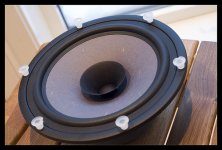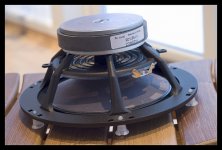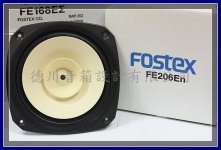Got mine today. 1st impression: packaging is unimpressive. Some of these are probably going to get damaged inside the packing box.
I believe that every SEAS Prestige driver I´ve bought have been delivered in the same kind of packaging that the FA22RCZ arrived in. Not great, but does the job. That´s if there is no loose objects in the same box, that could be hazardous.
Has anyone built an Aperiodic box? I am think of modding the sealed boxes with some home made 'variovents'.
I´ve built the recommended enclosure for the SEAS Exotic (as I´ve also have this driver), but the volume is the same 60 liter. I´m thinking about building some new and wider cabinets. I´ll probably also make it aperiodic, so any input on this will be much appreciated.
I bough 10.000 nth of SEAS drivers over the last 30 years and rarely had a broken one, so yes, the packaging is average but adaquate. I have shown a way to tame the treble by coating the wizzer and also did a rather big transmission line - reflex cabinet that works the bass quite well. The parameters allow it. a closed box may be simple but does not bring the best out in this rather low Qts, high Vas driver.
I bough 10.000 nth of SEAS drivers over the last 30 years and rarely had a broken one, so yes, the packaging is average but adaquate.
Over here the major carriers ( FEDEX/UPS/USPS/ etc) seem to have an ongoing contest to ignore shipping labels and continually refine ingenious methods and extents to which visible and concealed damage can be incurred to even very well packed goods.
The collective creativity is consistently amazing.
What approx volume / tuning / damping scheme did you find most effective?I have shown a way to tame the treble by coating the wizzer and also did a rather big transmission line - reflex cabinet that works the bass quite well. The parameters allow it. a closed box may be simple but does not bring the best out in this rather low Qts, high Vas driver.
The box is 40.5 cm wide, 29 cm deep and 120 cm high. Some 100 liters internal volume with aprox. 20mm strong sidewalls from chipboard and 20mm spruce front and back baffle. Internally are some stiffening and difusing boards that are not critical. The reflex tube is 10cm diameter and max. 28cm long, the end cut 45° to split the tramission resonance somewhat. The tube shows to the top that i found out is not optimal. I will move the tube to near the floor. The wizzer has one coat of liqiud polymer that made the treble response better from pus-minus 5dB to plus minus 2dB. I stuffed the box slightly with polyfill and use an LCR trap to get the midrange down.
Here is the result with and without the LCR trap.
Are both measurements done after coating?
From an earlier post I see you posted that you used the values "8.8 Ohm, 0.77mH and 3.2uF" for the trap, still the same values?
I´m currently using 3.9 Ohm, 0,56 mH and 4.7 uF. Will your values make the trap wider?
The green one is without the trap. The measurement is with coating. Without the response is very ragged and the sound is rather agressive and very dependant on angle. The trap is optimised for the baffle width and the position of the driver that i offset somewhat from the midlle aproximately at 3 to 5 or use the golden cut. My trap may not work on another baffle so i can not answer that question. There is a programm called "Edge" where you can simulate how the position and dimension of the baffle affects the driver response.
The easiest whould be to make a solution with Dammar in Spiritus. Put so much Dammar into the Spiritus until it is fully saturated. You can buy Dammar at the pharmacy. It is also used by artists to ground a painting. Use a small paint brush and coat it thin, wet in wet.
Wait for a day and coat it a second time. I did not use Dammar but a liquid polymer especially developped to coat membranes. I can not tell you the recipy. I buy it from a trusted source. I could imagine that you use a 2 component epoxy glue that does not dry too fast and thin it somewhat out. Try first your home made brew on old and cheep drivers. Gather experience. That is what i did. Also posible is a coat of Schellac. You can buy liquid Schellac for restoring historical furniture. You can also use violin laquer that is sold to intrument builders. I whould use a somewahrd hard variety. The trick seems to be that you stiffen and damp the wizzer so that it does not move caotically any more but more like one piece as a piston with a higher speed of sound then before. The peak and dipps come from out and in phase movement of the wizzer that interfer with the cone. It is a combfiltering effect.
Wait for a day and coat it a second time. I did not use Dammar but a liquid polymer especially developped to coat membranes. I can not tell you the recipy. I buy it from a trusted source. I could imagine that you use a 2 component epoxy glue that does not dry too fast and thin it somewhat out. Try first your home made brew on old and cheep drivers. Gather experience. That is what i did. Also posible is a coat of Schellac. You can buy liquid Schellac for restoring historical furniture. You can also use violin laquer that is sold to intrument builders. I whould use a somewahrd hard variety. The trick seems to be that you stiffen and damp the wizzer so that it does not move caotically any more but more like one piece as a piston with a higher speed of sound then before. The peak and dipps come from out and in phase movement of the wizzer that interfer with the cone. It is a combfiltering effect.
Last edited:
Has anyone built an Aperiodic box? I am think of modding the sealed boxes with some home made 'variovents'.
Interesting driver. Keep us informed of your progress.
IME, what little there is of it
I find that you get better results using room acoustics (room gain) to get better bass. Furthermore, I find that bass produced by FR speakers "slow" or "wooly." I think that because its a point source that group delay effects becomes easily discernable, simply because it stands-out, even if group delay is within one cycle. FR speakers may require as little as a quarter wavelength.
impression
Hi Dave,
Have you had a chance to test the FA22RCZ's and maybe treat them.
Any comment's on the improvement?
I'm thinking about buying a pair and attempt to treat them my self after breaking them in. After reading the latest burning amp article I want to try Mr.Pass's nice and simple OB with the F2J.
Thanks,
Eric
Hi Dave,
Have you had a chance to test the FA22RCZ's and maybe treat them.
Any comment's on the improvement?
I'm thinking about buying a pair and attempt to treat them my self after breaking them in. After reading the latest burning amp article I want to try Mr.Pass's nice and simple OB with the F2J.
Thanks,
Eric
Got mine today. 1st impression: packaging is unimpressive. Some of these are probably going to get damaged inside the packing box.
Open spider is nice... looks like room to put substantial damping on the front face of the magnet behind the spider.
Cone has interesting strands of light coloured stuff in it.
Cone shape & wizzer look vintage.
dave
Have you had a chance to test the FA22RCZ's and maybe treat them.
No they are still sitting untouched... drivers that people have bought are keeping them down in the queue
dave
I agree. One can say, that the SEAS FA22RCZ is better suitable, if there is no possibility to add a subwoofer system. Thus I can operate down to the aera arround 30Hz (i. e. real full range operation in a closed or vented box) because fres is also 30 Hz and the linear excursion (X-max) is much larger than 0,8mm - the X-max from the Fostex FE206En.They won't be in direct competition until the seas has proven itself to be DIY friendly, and a few ambitious diyer's have experimented with it. With the 30hz FS it's not IMO in direct comparison with really any fullranger I'm aware of.
If I use the Fostex FE206En in such an application, a high pass filter is necessary, even without the desire of an additional subwoofer. Nevertheless the highest possible output SP level is strongly limited. OTOH - the clearness and resoluition so as the dynamic behaviour of sonic quality is much more better in all respects (in opposite to the SEAS FA22RCZ) except inside the lowest frequencies.
by post #7 about
http://www.diyaudio.com/forums/full-range/171618-fostex-fe206en.html
you will find a Boom-Box (Hoge BB-4) simulation example from me include high pass filter in front of the FE206EN.
What could therefore the reason?
I think, mainly the material of the surround. Rubber composition with good acoustical behaviour - i. e. low losses independend of the degree of excursions - is still a challenge. SEAS (actually DKM) has useful but not the best ingredients for their rubber surrounds. Thus the Qms value was and is still very low and the audible sonic quality - particularly the resolution - can not exceed a certain level, especially in the lowest level aera. Fostex prefer textil rubbers.
An additional shortcoming is the magnet by this Seas full range model (to weak BL product) compare to the Fostex.
If I start with both models a loudspeaker project include a subwoofer operation (x-over arround 70 Hz), one can say, that both transducers will enhance enormously the sonic quality in the midrange - high frequency aera, mainly because the X-max is significantly lower by the same SP levels at both models - but only in cases, if one chooses a BB-4 alignment include a correct designed high pass filter.
Nevertheless the Fostex has even in this filtered (satellite box) mode still a significantly enhanced audible resolution in opposite to the SEAS (and all the other full range drivers with rubber surround).
Here the pdf datasheet URLs:
http://www.seas.no/images/stories/prestige/pdfdatasheet/h1597-08_fa22rcz_datasheet.pdf
http://www.fostexinternational.com/docs/speaker_components/pdf/FE206En.pdf
To investigate the exactly context in detail, I need an loudspeaker evaluation kit consisting of various magnets, spiders, cones (diaphragms) include voice coil, surrounds and baskets. I have seen such kits (special made for high end loudspeaker manufacturers) by a japanese supplier some years ago, unfortunately I can't find it in the moment.
Perhaps one of the members here can find the associate URL.
Attachments
Last edited:
Hello!
I need a little help from you guys. I have a DIY SET EL34 8W amp, and i need to upgrade my speakers. I settle to Fostex FE206En and Seas FA22RCZ. As far as i read on diyaudio, seems a 1-1 score. Given my SET amp, what would you suggest.
What i need to add, is that i would like something like a shelf speakers cabinet, sealed or BR. Space is a major problem.
But if you can convince me to build TQWT... for major sonic improvement, i think i can throw out something from the house
Best regards,
Alex.
I need a little help from you guys. I have a DIY SET EL34 8W amp, and i need to upgrade my speakers. I settle to Fostex FE206En and Seas FA22RCZ. As far as i read on diyaudio, seems a 1-1 score. Given my SET amp, what would you suggest.
What i need to add, is that i would like something like a shelf speakers cabinet, sealed or BR. Space is a major problem.
But if you can convince me to build TQWT... for major sonic improvement, i think i can throw out something from the house
Best regards,
Alex.
Here are three designs you might look at is space is limited. They have small footprints.
http://www.humblehomemadehifi.com/download/Humble Homemade Hifi_Solo-206_copy.pdf
http://p10hifi.net/FH/downloads/SpawnHorn-v2-planset-070412.pdf
http://p10hifi.net/FH/downloads/Dallas2-plans-redraw-270113.pdf
http://www.humblehomemadehifi.com/download/Humble Homemade Hifi_Solo-206_copy.pdf
http://p10hifi.net/FH/downloads/SpawnHorn-v2-planset-070412.pdf
http://p10hifi.net/FH/downloads/Dallas2-plans-redraw-270113.pdf
- Status
- This old topic is closed. If you want to reopen this topic, contact a moderator using the "Report Post" button.
- Home
- Loudspeakers
- Full Range
- SEAS FA22RCZ vs. Fostex FE206En



